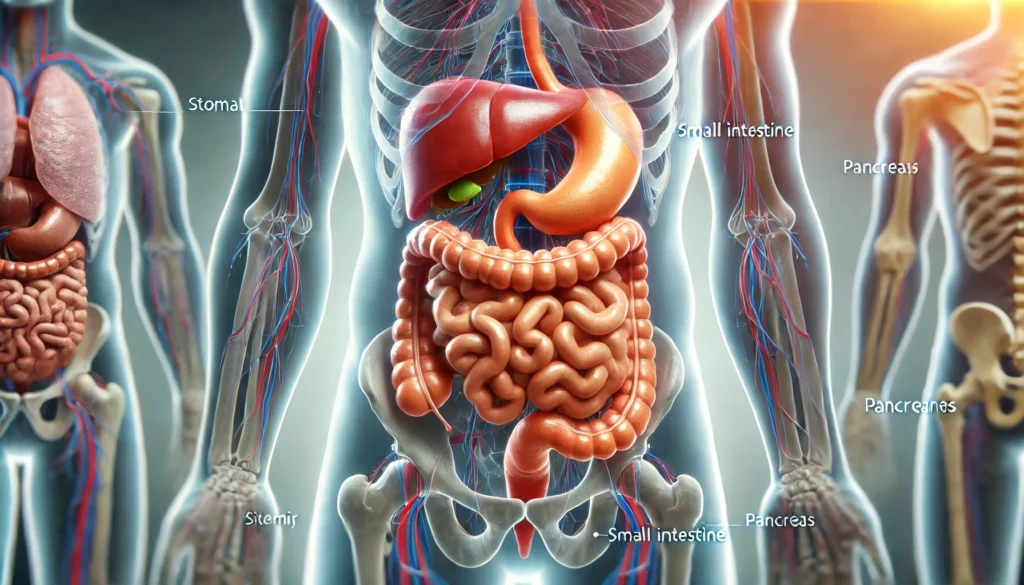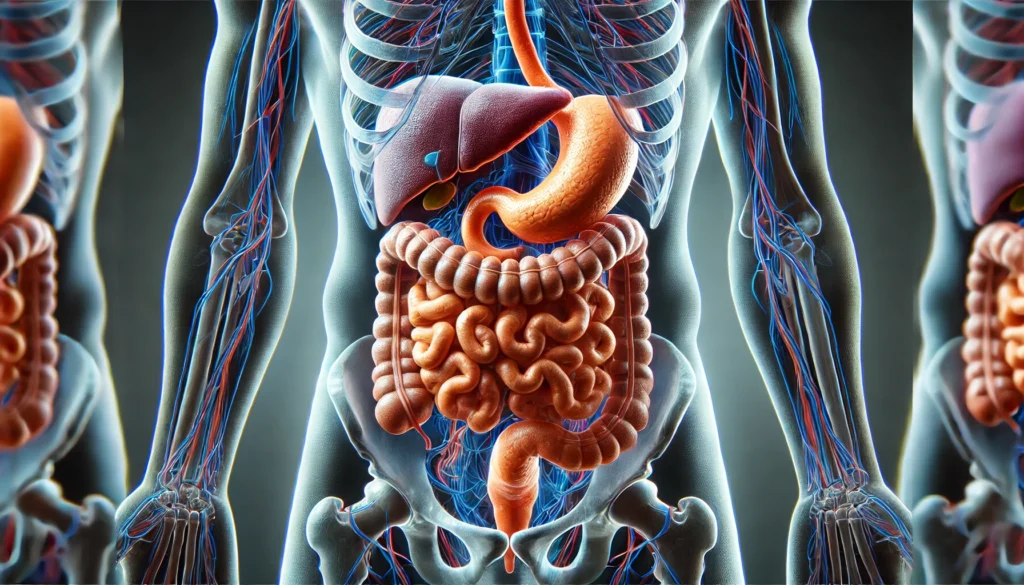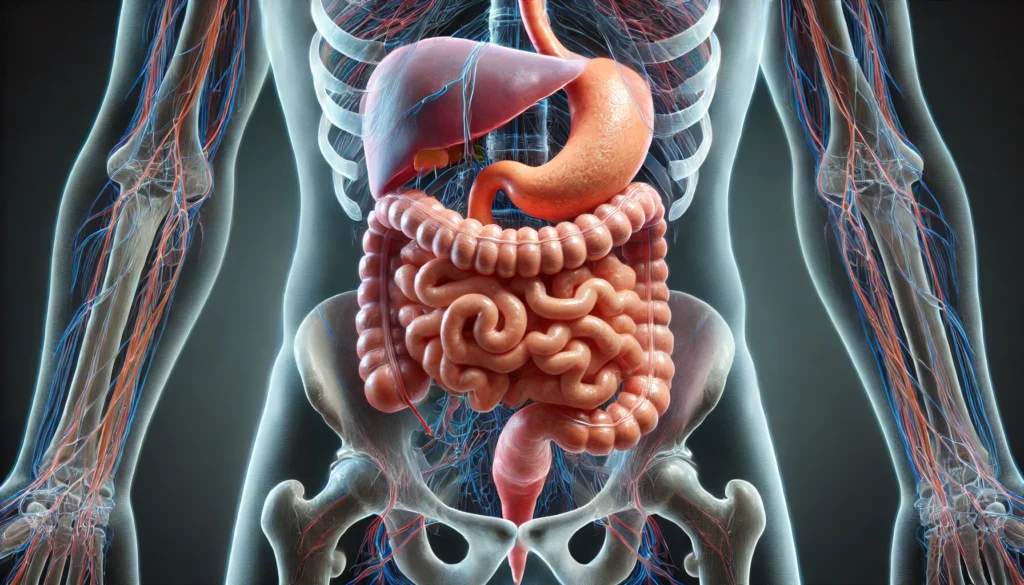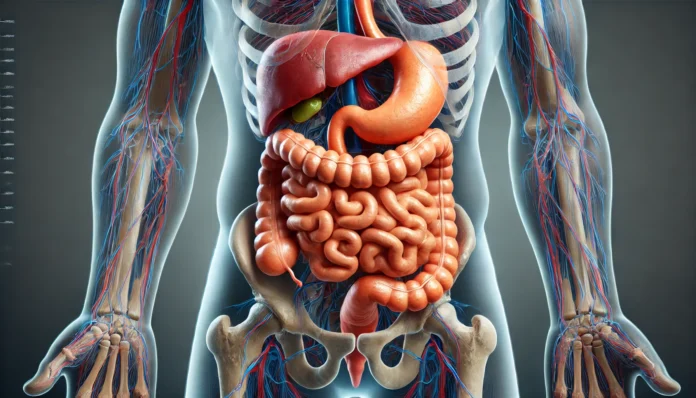Understanding the Human Digestive System
The human digestive system is a complex network of organs and structures working together to break down food, absorb nutrients, and eliminate waste. This intricate process ensures that the body receives essential vitamins, minerals, and energy necessary for survival. A thorough examination of the human digestive system diagram provides a clearer understanding of how food moves through the body and where the majority of digestion occurs. From ingestion to elimination, each stage of digestion plays a critical role in maintaining health and well-being. Understanding the function of each organ, from the mouth to the intestines, allows for an in-depth appreciation of human digestive anatomy.
You may also like: How to Improve Gut Health Naturally: Science-Backed Tips for a Stronger Microbiome
The Digestive Process: From Ingestion to Absorption
Digestion begins in the mouth, where food is chewed and mixed with saliva to start breaking down carbohydrates. The bolus, or softened food mass, then travels down the esophagus into the stomach. The stomach’s acidic environment and enzymatic activity contribute to breaking down proteins. However, digestion is not completed here; the primary site of nutrient breakdown and absorption lies further along the gastrointestinal (GI) tract. By examining a labeled diagram of the human digestive system, one can see that most digestion occurs in the small intestine, where enzymes from the pancreas and bile from the liver facilitate the breakdown of fats, proteins, and carbohydrates into absorbable molecules.
The Role of the Stomach in Digestion
The stomach plays a significant but limited role in digestion. While it primarily functions as a temporary food reservoir, it also secretes gastric juices containing hydrochloric acid and digestive enzymes like pepsin, which break down proteins. The stomach’s churning motion ensures thorough mixing of food with digestive secretions, creating a semi-liquid substance called chyme. Despite its essential contribution, the stomach does not complete digestion. Instead, it prepares food for further processing in the small intestine, where enzymatic action takes center stage. As depicted in a detailed human digestive system diagram, the stomach serves as a crucial intermediary organ in the digestive journey.
The Small Intestine: The Primary Site of Digestion
The small intestine is the most vital organ in digestion and nutrient absorption. Consisting of three sections—the duodenum, jejunum, and ileum—the small intestine is lined with villi and microvilli, which increase surface area and enhance nutrient absorption. The duodenum is where the majority of digestion occurs, as it receives bile from the liver and pancreatic enzymes, which break down complex molecules into absorbable forms. The jejunum and ileum then facilitate nutrient absorption into the bloodstream. A properly labeled diagram of digestion highlights the small intestine as the central hub of nutrient assimilation.
The Role of Enzymes and Bile in Digestion
Enzymes and bile are critical components of the digestive process. The pancreas secretes enzymes such as amylase, lipase, and proteases, which break down carbohydrates, fats, and proteins, respectively. Meanwhile, bile from the liver emulsifies fats, making them more accessible to digestive enzymes. Without these substances, digestion would be incomplete, leading to malabsorption and nutritional deficiencies. A simple digestive system diagram outline illustrates how these digestive fluids interact with food to facilitate efficient breakdown and absorption. Understanding their function clarifies the significance of enzymatic activity in human digestion.
The Large Intestine and Waste Elimination
While digestion primarily occurs in the small intestine, the large intestine plays an essential role in water absorption and waste elimination. By the time food reaches the colon, most nutrients have already been absorbed. The large intestine houses beneficial bacteria that help ferment undigested carbohydrates and synthesize certain vitamins, such as vitamin K. The final step in digestion involves the formation of feces, which are then expelled from the body. A digestive tract labeled diagram highlights the large intestine’s role in maintaining hydration and waste excretion.

Common Digestive Disorders and Their Impact
Understanding the digestive system also involves recognizing potential disorders that can disrupt its function. Conditions such as gastroesophageal reflux disease (GERD), irritable bowel syndrome (IBS), Crohn’s disease, and celiac disease can impair digestion and absorption. Symptoms like bloating, constipation, diarrhea, and acid reflux may indicate an underlying digestive issue. By analyzing digestive system images and diagnostic diagrams, healthcare professionals can identify abnormalities and develop appropriate treatment plans. Maintaining digestive health through a balanced diet, hydration, and medical interventions is crucial for preventing digestive disorders.
The Importance of a Healthy Digestive System
A healthy digestive system is fundamental to overall well-being. Proper digestion ensures that the body receives essential nutrients, supports immune function, and prevents gastrointestinal discomfort. Lifestyle factors such as diet, hydration, exercise, and stress management influence digestive efficiency. Incorporating fiber-rich foods, probiotics, and adequate fluids can enhance digestive function and prevent complications like constipation or acid reflux. As depicted in human digestive anatomy diagrams, each organ works in harmony to maintain optimal health. Understanding these relationships empowers individuals to make informed dietary and lifestyle choices.

Frequently Asked Questions (FAQ) on Digestion and the Human Digestive System
What is the significance of the small intestine in digestion?
The small intestine is the primary site of digestion and nutrient absorption, playing a vital role in breaking down carbohydrates, proteins, and fats into smaller molecules that the body can utilize. It consists of three sections: the duodenum, where the majority of digestion occurs, and the jejunum and ileum, where nutrients are absorbed into the bloodstream. The small intestine’s extensive surface area, facilitated by villi and microvilli, enhances nutrient absorption efficiency. Pancreatic enzymes and bile contribute to the breakdown of complex food molecules, ensuring that the body receives the necessary nutrients for energy and cellular functions. A human digestive system diagram labeled with detailed sections helps in understanding this process visually.
Why does the stomach not complete digestion?
Although the stomach initiates digestion by breaking down proteins with gastric acid and enzymes, it does not complete the entire process. Its primary role is to liquefy food into chyme, a semi-fluid mass that passes into the small intestine for further breakdown. The stomach lacks enzymes to fully digest carbohydrates and fats, relying on the pancreas and liver to supply the necessary digestive substances. A diagram of digestion illustrates how the stomach acts as an intermediary, preparing food for enzymatic breakdown in the small intestine. The human digestive anatomy diagram provides insights into why different organs play specialized roles in digestion.
How does the large intestine contribute to digestion?
While the majority of digestion occurs in the small intestine, the large intestine plays a crucial role in processing waste and absorbing water. It hosts beneficial bacteria that aid in breaking down undigested fibers and synthesizing vitamins such as vitamin K and certain B vitamins. This process is essential for maintaining gut health and preventing digestive issues such as constipation. A digestive tract labeled diagram shows how the colon structures aid in compacting waste before elimination. Without a properly functioning large intestine, hydration balance and nutrient synthesis would be compromised.
What role does bile play in digestion?
Bile, produced by the liver and stored in the gallbladder, is crucial for the digestion and absorption of fats. It acts as an emulsifier, breaking large fat molecules into smaller droplets, making them more accessible to digestive enzymes like lipase. Without bile, fat digestion would be inefficient, leading to malabsorption and potential nutritional deficiencies. A human digestive system diagram labeled with the liver and gallbladder shows the pathway through which bile enters the digestive tract. Understanding bile’s function is essential in recognizing the impact of liver and gallbladder disorders on digestion.
How does the digestive system interact with the nervous system?
The digestive system is closely connected to the nervous system, particularly through the enteric nervous system, often referred to as the “second brain.” This network of neurons within the gastrointestinal tract regulates motility, enzyme secretion, and blood flow. The gut-brain axis also plays a role in digestion, influencing hunger, satiety, and stress responses. Psychological stress can slow digestion, leading to symptoms such as bloating or indigestion. A diagram of the human digestive tract helps illustrate the complex relationship between neurological signals and digestive processes. Understanding this interaction can help in managing digestive disorders linked to stress and mental health.
What is the impact of fiber on digestion?
Dietary fiber is essential for maintaining a healthy digestive system, as it promotes regular bowel movements and supports gut microbiota. Soluble fiber absorbs water and forms a gel-like substance, aiding in digestion and stabilizing blood sugar levels, while insoluble fiber adds bulk to stool, preventing constipation. A simple digestive system diagram outline highlights the movement of fiber through the intestines. Consuming adequate fiber from whole grains, fruits, and vegetables is essential for optimal gut health. Studies show that fiber-rich diets reduce the risk of digestive disorders such as diverticulosis and irritable bowel syndrome.
How does aging affect the digestive system?
As the body ages, digestive efficiency declines due to changes in enzyme production, gut motility, and microbiota composition. Older adults often experience slower digestion, leading to constipation and nutrient malabsorption. The production of stomach acid may also decrease, affecting protein digestion and mineral absorption. Digestive system images illustrating these changes can help in understanding why dietary modifications are necessary as people age. Ensuring a fiber-rich diet, proper hydration, and probiotic intake can help maintain digestive health in older individuals.
Why do digestive enzymes vary among individuals?
Genetic variations, diet, and overall health influence the levels and activity of digestive enzymes in individuals. Some people naturally produce more lactase, the enzyme responsible for digesting lactose, while others may have deficiencies leading to lactose intolerance. Similarly, variations in amylase levels affect carbohydrate digestion efficiency. A digestive system photo depicting enzyme activity can help visualize these biochemical processes. Understanding enzyme variability is essential for personalized nutrition and managing food intolerances effectively.
How do probiotics support digestive health?
Probiotics are beneficial bacteria that promote a balanced gut microbiome, supporting digestion and immune function. They help break down undigested food particles, produce essential vitamins, and protect against harmful pathogens. Fermented foods such as yogurt, kimchi, and sauerkraut are rich sources of probiotics. A human digestive system diagram labeled with gut microbiota regions illustrates how probiotics interact with different parts of the digestive tract. Regular probiotic intake has been linked to improved digestion and reduced symptoms of conditions like irritable bowel syndrome and inflammatory bowel disease.
Can lifestyle changes improve digestion?
Yes, adopting healthy lifestyle habits significantly enhances digestive function. Regular physical activity promotes gut motility, reducing the risk of constipation and bloating. Hydration supports enzymatic reactions and nutrient absorption, preventing digestive discomfort. Stress management techniques such as meditation and deep breathing exercises can mitigate the impact of stress on the digestive system. A digestion process diagram helps visualize the importance of these lifestyle choices in maintaining a functional digestive system. Consistently making mindful dietary and lifestyle choices contributes to long-term gut health and overall well-being.

Conclusion: A Comprehensive View of Digestion
Digestion is a multifaceted process that occurs throughout the gastrointestinal tract, but the majority of nutrient breakdown and absorption takes place in the small intestine. By examining the human digestive system labeled diagrams, one can appreciate the complexity of this vital function. From enzymatic activity in the duodenum to nutrient absorption in the jejunum and ileum, each phase of digestion plays an essential role in sustaining life. Maintaining digestive health through proper nutrition, hydration, and lifestyle choices ensures optimal function and well-being. Understanding the digestive process equips individuals with the knowledge to support their health through informed decisions about diet and lifestyle.
digestive health guide, gastrointestinal function, nutrient absorption process, gut microbiome balance, digestive enzymes and bile, stomach acid production, small intestine function, large intestine health, food breakdown process, healthy digestion tips, gut-brain connection, fiber for digestion, probiotics and gut health, digestive system efficiency, optimal gut function, digestion and metabolism, hydration for digestion, enzyme activity in digestion, common digestive disorders, diet for digestive wellness
Further Reading:
Digestive System: Function, Organs & Anatomy
Overview of the Digestive System
Disclaimer
The information contained in this article is provided for general informational purposes only and is not intended to serve as medical, legal, or professional advice. While Health11News strives to present accurate, up-to-date, and reliable content, no warranty or guarantee, expressed or implied, is made regarding the completeness, accuracy, or adequacy of the information provided. Readers are strongly advised to seek the guidance of a qualified healthcare provider or other relevant professionals before acting on any information contained in this article. Health11News, its authors, editors, and contributors expressly disclaim any liability for any damages, losses, or consequences arising directly or indirectly from the use, interpretation, or reliance on any information presented herein. The views and opinions expressed in this article are those of the author(s) and do not necessarily reflect the official policies or positions of Health11News.


